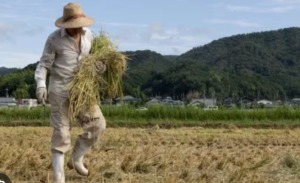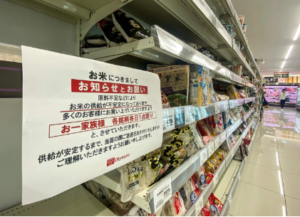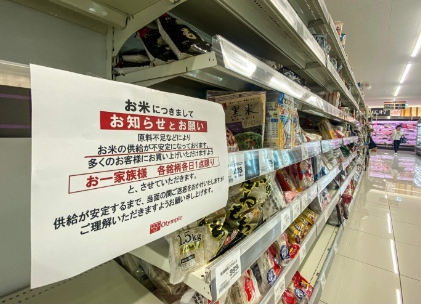Japan is confronting its most severe rice shortage in decades, as a perfect storm of adverse weather, booming tourism, and restrictive rice policies sends rice stocks to historic lows. The crisis is sending shockwaves through Japanese households and food services, threatening staples like sushi, onigiri, and yakitori.
Record Demand Strains Supply
Supermarkets across Japan have been rationing rice, often limiting customers to one bag per purchase. The shortage, which has left store shelves bare in many regions, is primarily due to rising demand as tourism rebounds to record levels. Japan welcomed 17.8 million visitors in the first half of 2024 alone, far surpassing pre-pandemic numbers. Hungry for sushi and other rice-based dishes, tourists have significantly increased rice consumption. From July 2023 to June 2024, rice consumption by tourists more than doubled, rising from 19,000 to 51,000 tons.
Weather and Natural Disasters Fuel Stockpiling
The situation has been worsened by severe weather events, including heatwaves and droughts, which have drastically impacted the rice harvest. As typhoon season approaches and earthquake warnings circulate, Japanese consumers are stockpiling rice, depleting supplies even further. The U.S. Department of Agriculture reports that Japan’s rice stocks have plunged to their lowest levels in over 20 years, driving prices up.
In August, the price of rice rose 3%, reaching 16,133 yen ($112.67) per 60kg. This increase, compounded by rising energy and food costs, has fueled inflation, with rice becoming one of the largest contributors to Japan’s 2.8% year-on-year inflation in August.
Aging Farmers and Restrictive Policies Add to the Crisis
Japan’s rice industry is also grappling with long-term structural challenges. An aging farming population and a lack of young workers have steadily eroded rice production. At the same time, Japan’s rigid rice policies, including a 778% tariff on imported rice, keep the market isolated from global suppliers. Despite importing around 682,000 tons of rice annually under World Trade Organization obligations, this rice is largely used for processing and animal feed, limiting its impact on consumer supply(
Rising Rice Prices Exacerbate Inflation
As rice stocks dwindle, prices continue to surge, contributing to higher food inflation. Japan, already struggling with rising energy costs, now faces pressure from escalating food prices, with rice and chocolate being among the top drivers in the inflation basket
What’s Next?
Japan’s rice shortage is expected to continue, with no immediate relief in sight. While tourists have driven a spike in demand, the country’s aging farming industry and protective tariffs are long-standing challenges. Unless Japan adjusts its rice policies or experiences a significant recovery in crop yields, the nation may face prolonged shortages and higher prices for its most essential food staple.

To dive deeper into Japan’s rice shortage, here’s a breakdown of more data and insights from various sources:
- Rice Stocks at Historical Lows: Japan’s rice inventories have plummeted to their lowest levels in over 20 years. According to the Ministry of Agriculture, Forestry, and Fisheries (MAFF), Japan’s private rice inventories stood at 1.56 million tons as of June 2024. This drastic reduction is attributed to multiple factors including weather disruptions and panic buying from locals preparing for typhoons and earthquakes.
- Impact of Tourism: As the tourism industry rebounds to record highs post-pandemic, the demand for rice has surged. The number of tourists spiked to 3.3 million in July 2024, the highest ever recorded. Tourists, particularly drawn to rice-based dishes like sushi, have more than doubled their rice consumption year-over-year. In total, tourists consumed 51,000 tons of rice between July 2023 and June 2024, a stark increase from the previous year.
- Weather Challenges: Japan’s rice production has been severely impacted by extreme weather, with heatwaves and drought conditions affecting crop yields. These environmental factors are expected to continue influencing future harvests, putting more pressure on the already tight supply.
- Tariff and Policy Constraints: Japan’s rice policies impose a 778% tariff on imported rice to protect domestic farmers. Although Japan imports around 682,000 tons of rice annually due to WTO obligations, this rice is mainly used for non-consumer purposes such as processing and feed, isolating Japanese consumers from potential relief through imports. This policy structure makes it challenging for the country to rely on global rice markets for immediate help.
- Economic and Inflationary Pressures: The shortage is driving up rice prices, which increased by 5% in 2024, pushing inflation higher. Alongside food items like chocolate, rice has become one of the largest contributors to Japan’s 2.8% inflation rate in August.
- These factors together form a complex scenario where weather, tourism, and rigid economic policies are all contributing to the ongoing rice crisis in Japan. The country’s reliance on domestic production, compounded by increasing demand from both locals and tourists, is placing a strain on rice availability.






